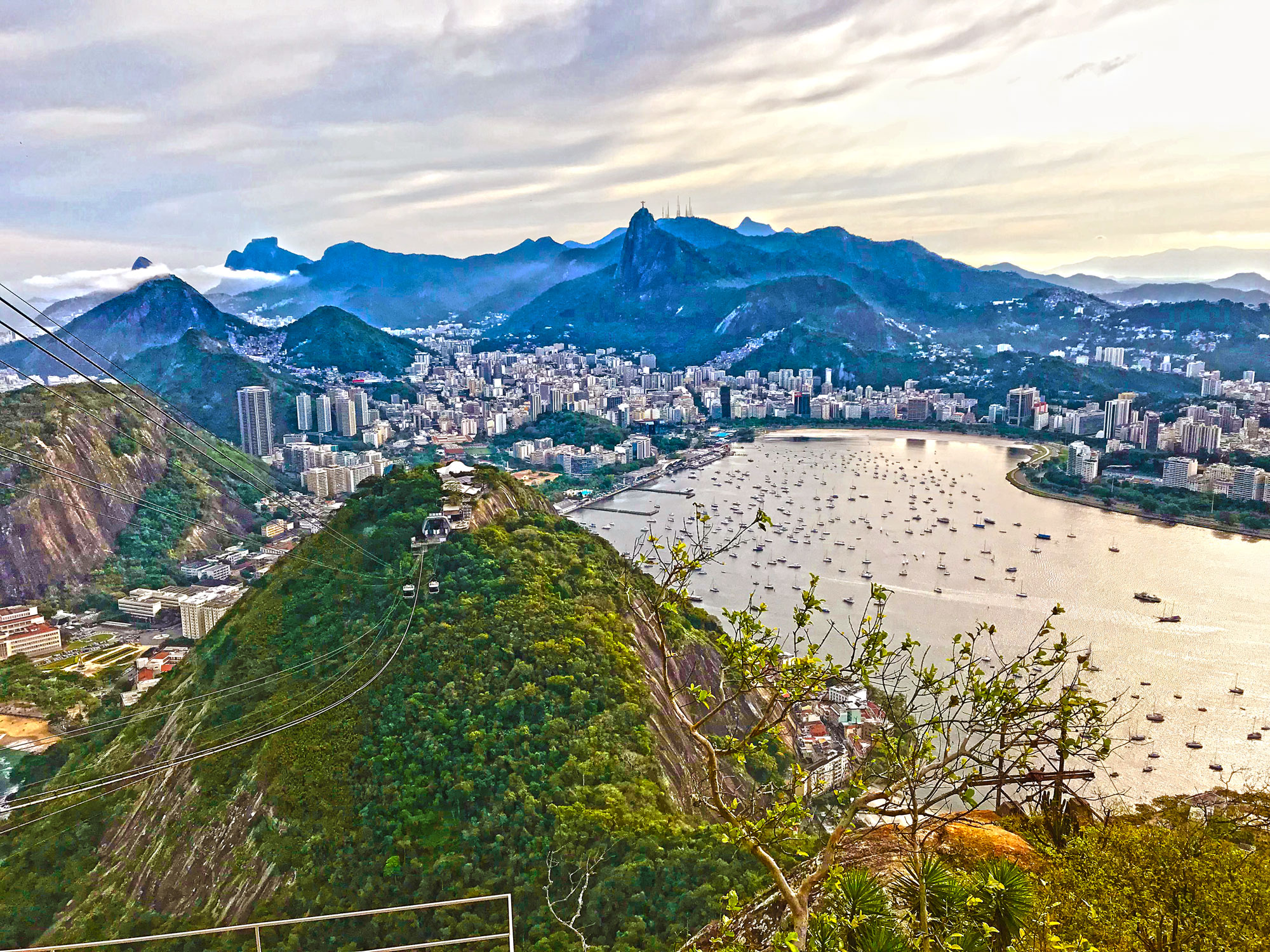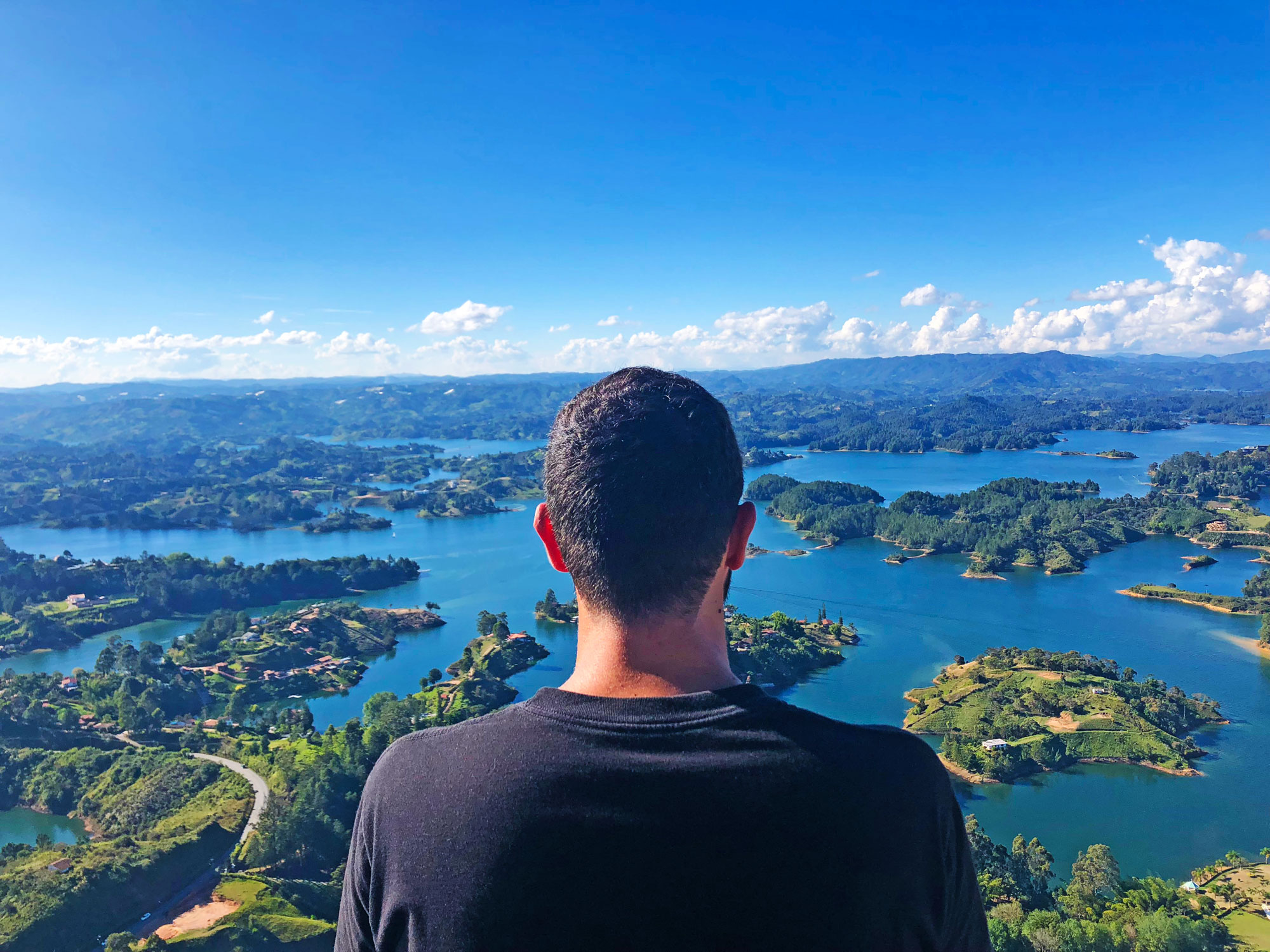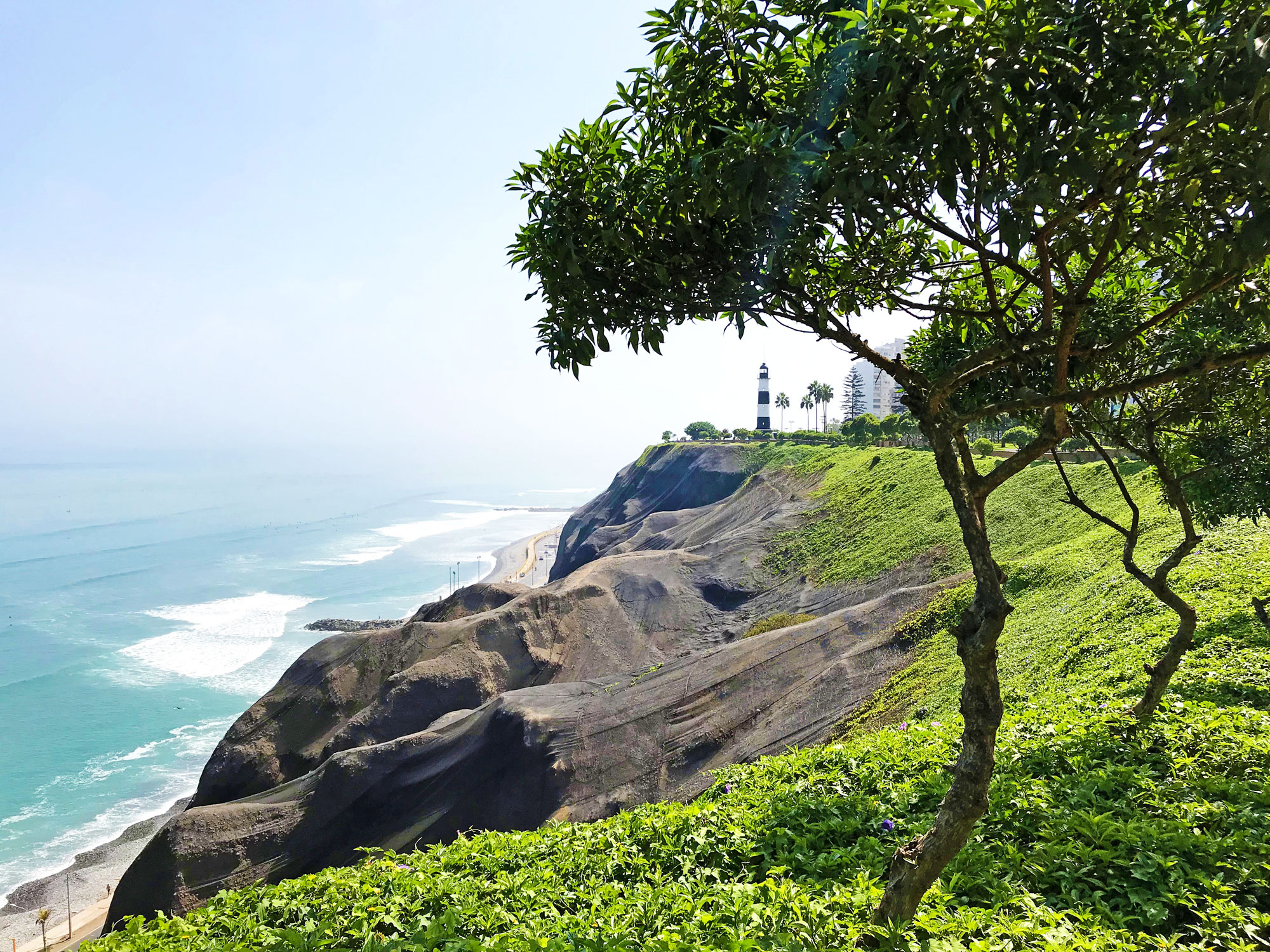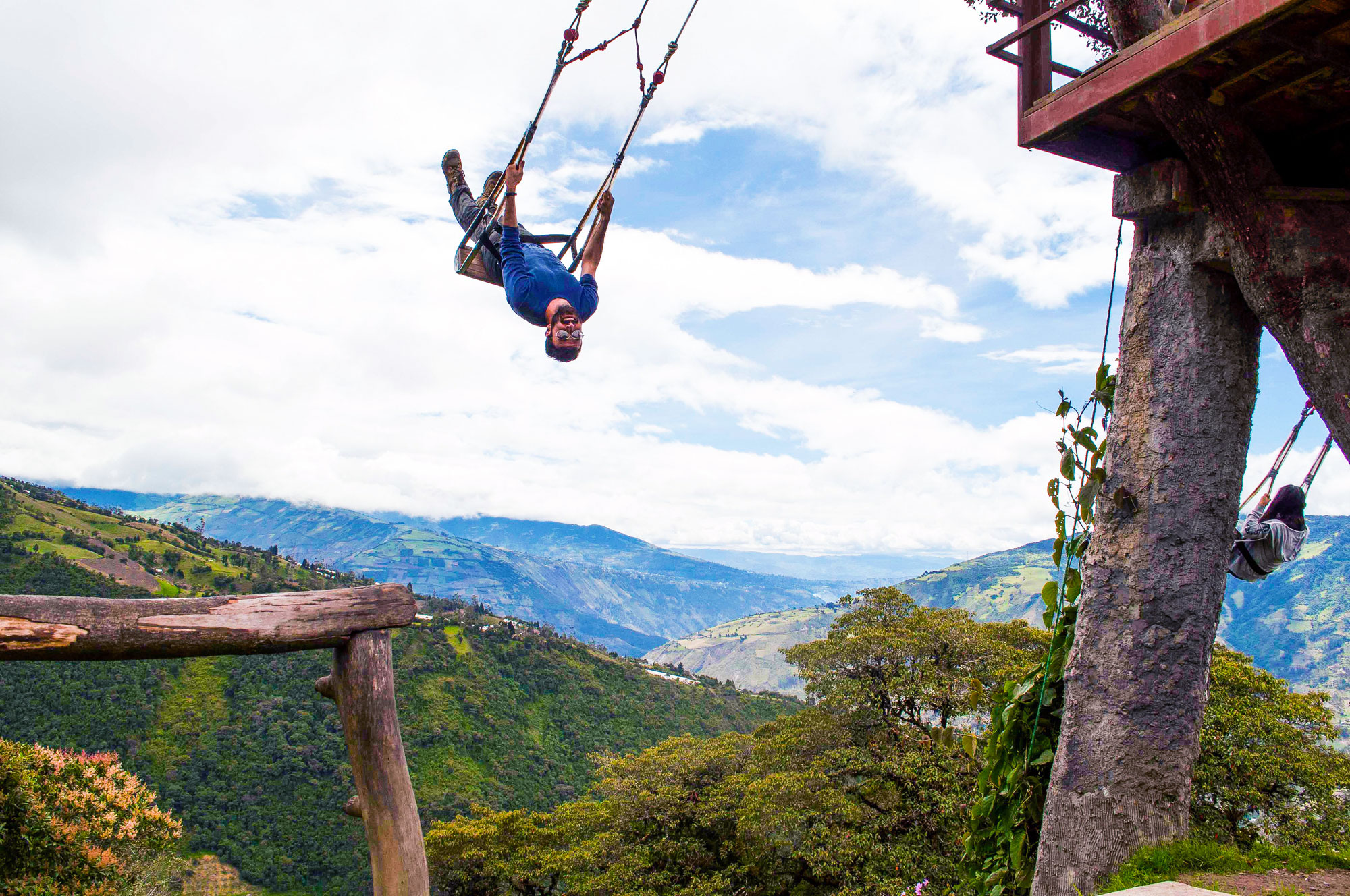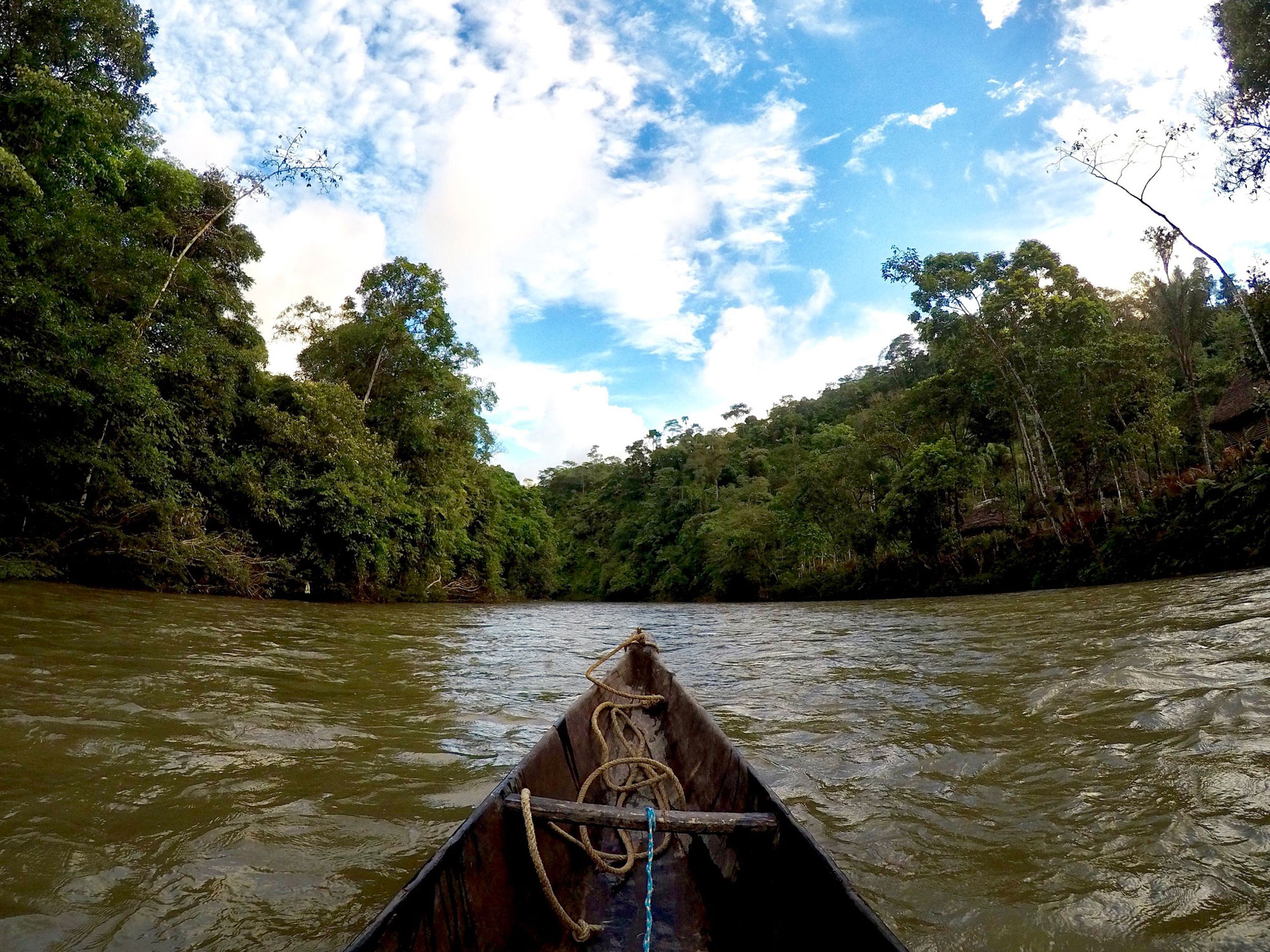I have just left Rio de Janeiro after a month spent there with WifiTribe and I’m already looking forward to coming back! For me, Rio is the best city in the world! Nature, landscapes, people, culture… everything is just amazing!
The city
Cidade maravilhosa Cheia de encantos mil Cidade maravilhosa Coração do meu Brasil
If Rio is called Cidade maravilhosa, it’s for a reason! What I love is that it’s a city in the jungle: it stretches among green hills full of Amazonic vegetation, perfectly integrated with nature. In just a few minutes walking, you can find yourself deep in the jungle, forgetting about being in a city with 6 millions of people.
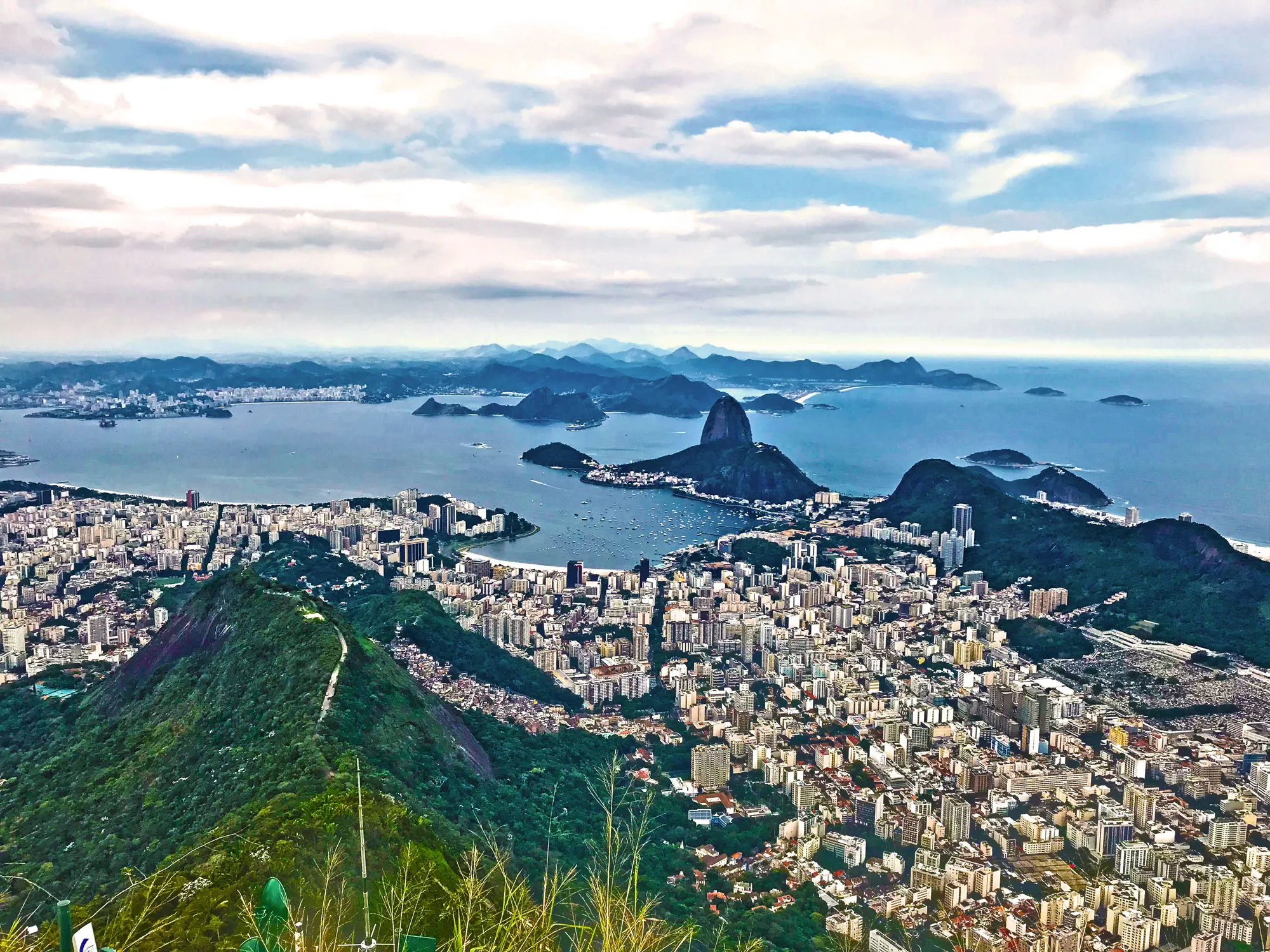
The view from the Corcovado hill
I would dare to say that Rio is the Barcelona of South America. Just like its European sister, it’s a big city with amazing culture and traditions, with beautiful city beaches with a long walkway you can cover by walking or by biking. Streets are large, with many big squares and open spaces among buildings. Of course, I cannot compare Barcelona’s architecture with Rio’s as the latter has nothing to do with the former. Almost all the colonial buildings have been shut down in order to build ugly skyscrapers, apart from something in the Santa Teresa district and a church in the Center.
Views from the hills of Cordovado (the famous one with the Christ) and from Pão de Açúcar are simply breathtaking, as you can admire the city from above in all its glory, from many different perspectives.
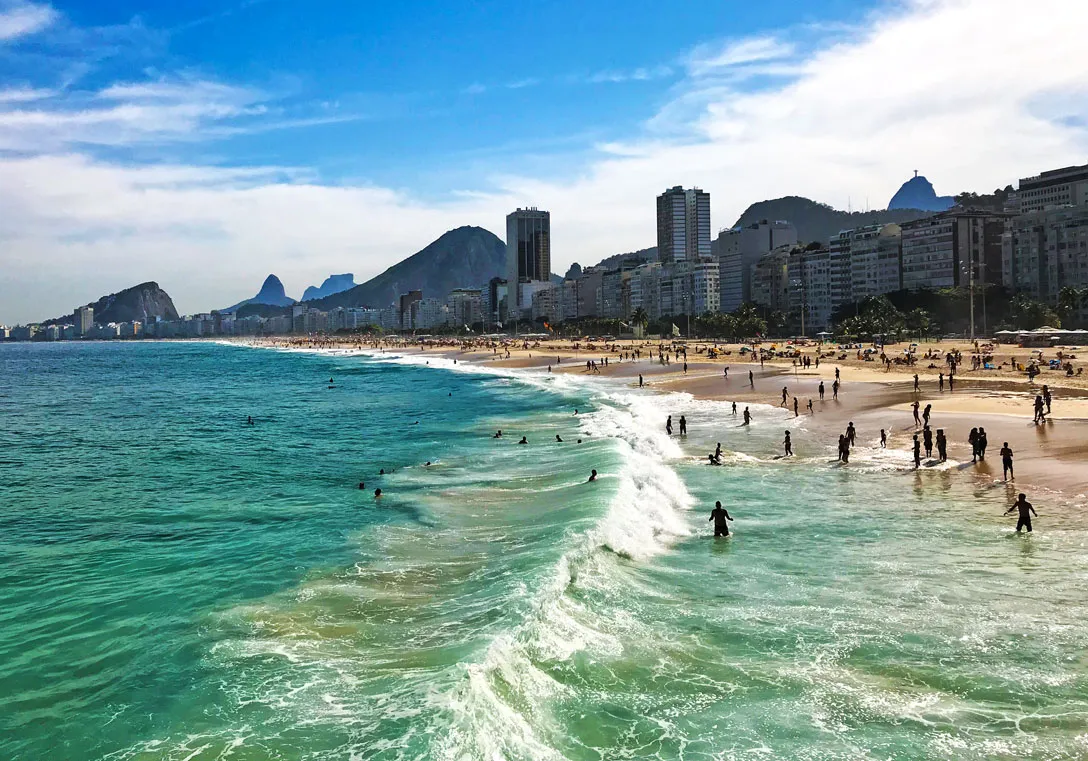
The beach of Copacabana
Our apartment was in Copacabana, near the most famous beach in the world. Actually, it’s a nice city beach, but nothing really special. There are way nicer beaches just outside Rio. Anyway, it was nice having a walk or a run on the beach in the morning before working, drinking a caipirinha in the kiosks on the walkway and playing volleyball in one of the many courts on the beach.
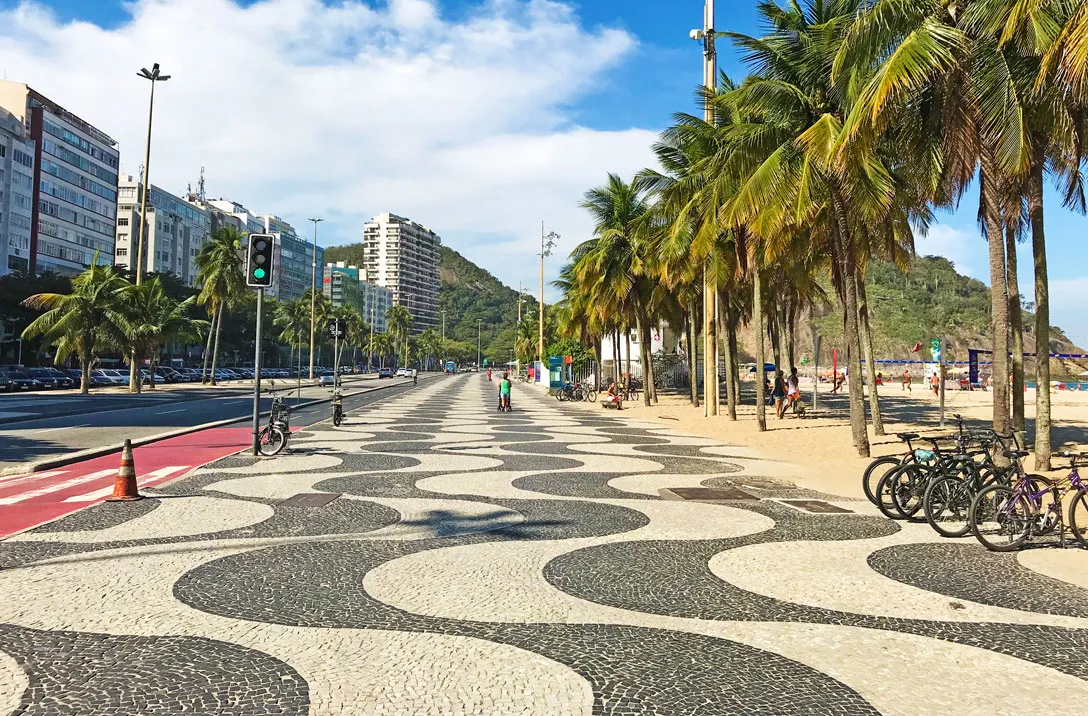
The famous Copacabana walkway
Volleyball is very famous in Brazil, but what they play the most is footvolley: a Brazilian invention that consists of playing volleyball using just your feet, head and chest. And they are very good at it and every game is a show worth watching.
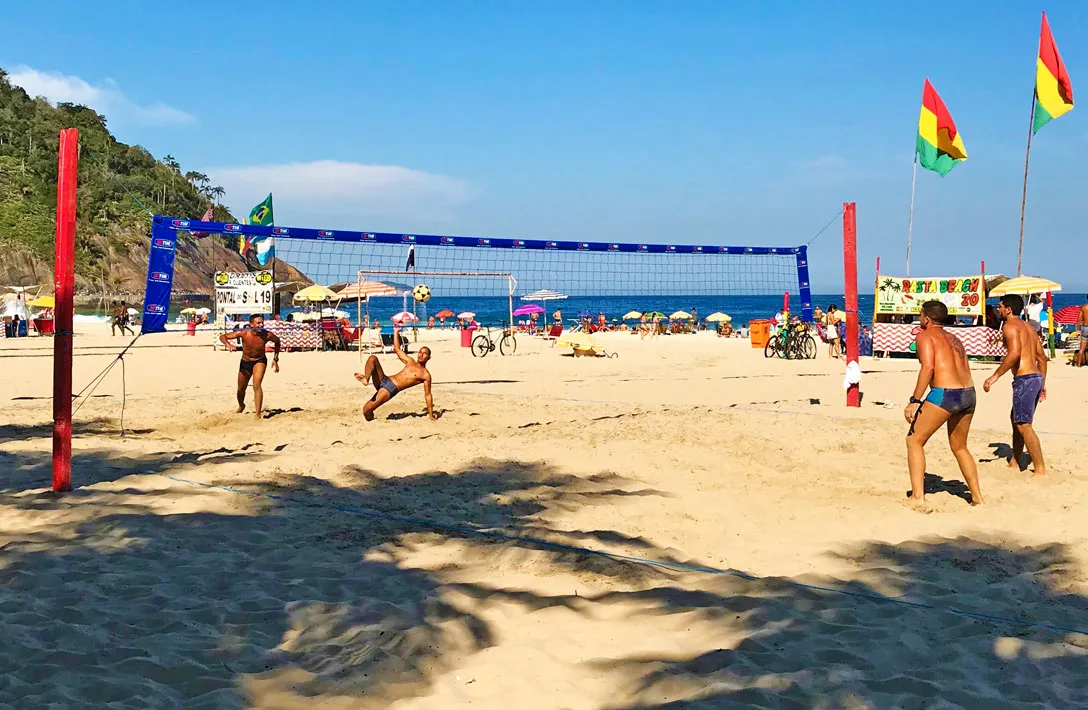
Locals playing footvolley in Copacabana beach
The district of Ipanema is also nice and very close to Copacabana: it’s located between the Ipanema beach and the Lagoa, a big lake where you can practice standup paddle or kayak.
The district of Center is the most historic one, where you can find the French Teather, the library, museums and the institutional buildings. Closeby there is Lapa, the nightlife district that comes alive every night with samba shows, live music and caipirinhas!
Finally, another district worth mentioning is Santa Teresa, the hipster area with many nice bars and pubs where you can eat local bar food and drink cheap local beer (chopp) or artisanal cachaça.
Culture
What makes Brazil so different from the other countries of South America is the different culture and, of course, the different language.
In Rio, samba and forró are the main things: every night you can find live music in Lapa in places like Rio Scenarium and Leviano Bar. But there are also hidden places that just locals know with samba parties or directly in the streets of Santa Teresa.
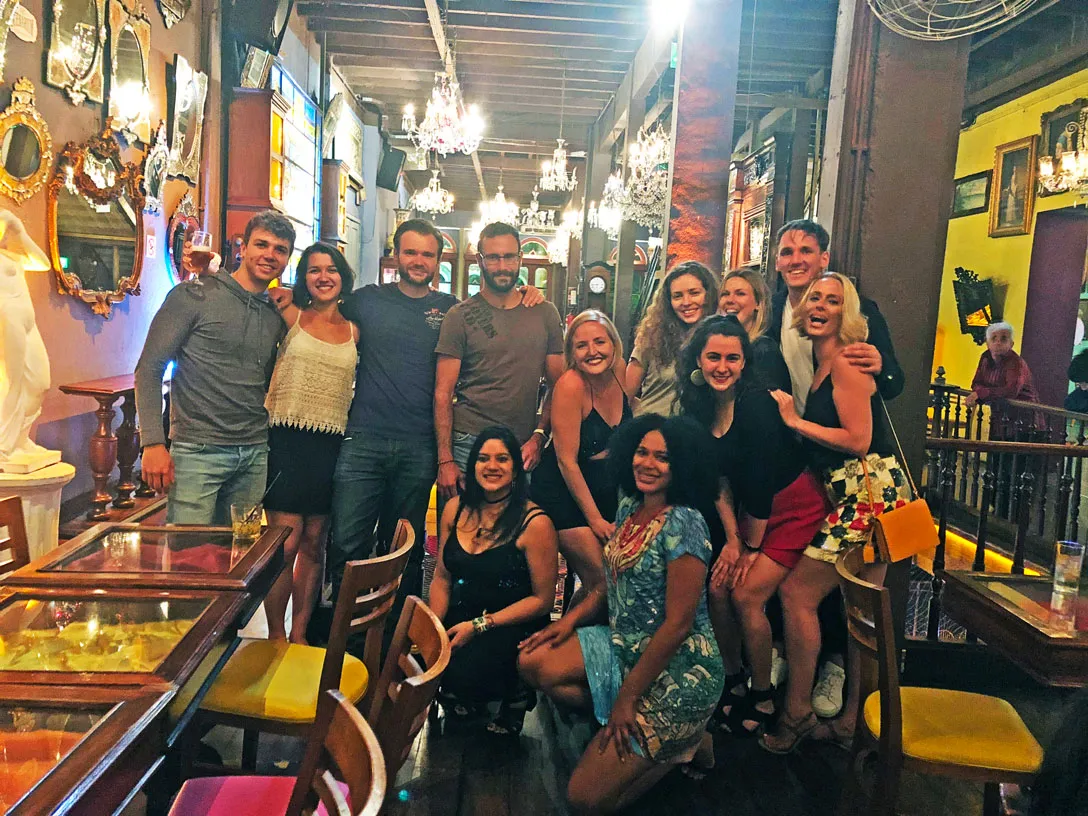
At Rio Scenarium with the Tribe
A must to go place is Bip Bip, a very small historic bar where the best samba players meet since 1968 for playing together and enjoying samba and bossa nova jam sessions. Go there, grab a beer and stand outside of the bar, listening to a very local show.

Live samba jam session at Bip Bip
Moreover, every year from August, Samba schools start their training for the Carnival and open their doors to anyone who wants to see their shows (and party until morning!).
Ipanema has its role in bossa nova’s history too, as you can visit the Garota de Ipanema’s bar, the place where Vinícius de Moraes and Antônio Carlos Jobim wrote the famous song The girl from Ipanema. And you can still have the chance of meeting that pretty girl (not young anymore) walking along the street where she is still living.
And let’s not forget capoeira, the famous Brazilian martial art, mixed with dance and acrobatics. I used to practice capoeira when I lived in Italy and I was looking forward to doing it in Brazil! So I subscribed to the Grupo Senzala in Copacabana and I did it 3 times per week for a month: I love it!
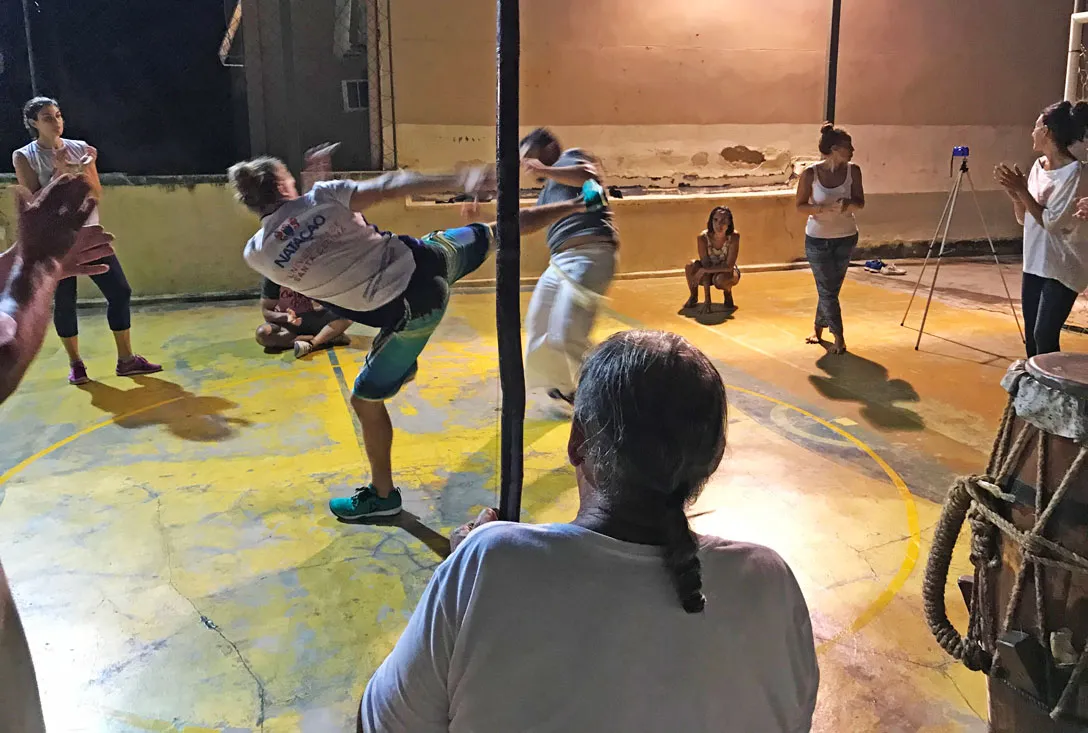
A capoeira class
Food
At the beginning I wasn’t really astonished by food: I tried the famous feijoada, but I didn’t like it so much, especially due to the pork scrapes you find inside.
And I haven’t had the chance to try the c_hurrasco_, a selection of grilled meat usually in a all-you-can-eat formula! The Churrascaria Palace is the most famous.
Anyway, I started to appreciate Brazilian cuisine when I tried fish courses. You should try the moqueca, a very tasty fish stew from Bahia, usually with shrimps.
But what I like the most are petiscos, the bar food. It reminds me Spanish tapas as they are little portions of (usually) fried food that you can eat at any bar, while drinking a beer or a caipirinha. My favorite are bolinhos de bacalhau (fried cod balls), pastel de queijo (fried thin pastry envelopes wrapped around cheese) and coração de palmito (palm’s heart). Pavão Azul in Copacabana is one of the best bars where you can try all this food, but you should also check the famous Bar do Mineiro in Santa Teresa.

Coração de palmito
Other typical dishes I enjoyed — thanks to a local friend who suggested me all the best places and things to eat — are escondidinho de carne seca (mashed aipim that hides dry meat in the middle) and carne de sol, a very tender sun-dried beef.
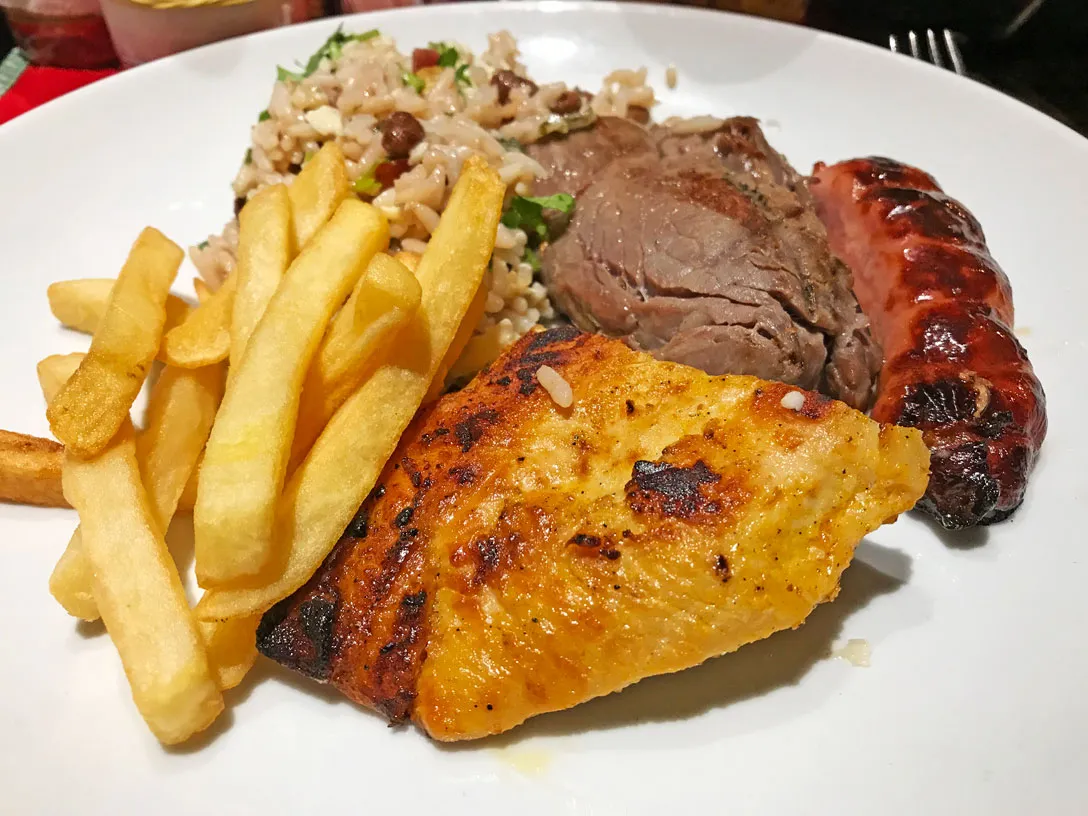
A meat mix: carne de sol, chicken and local sausage
Have no fear, you should also try street food! It looked way safer than Ecuadorian or Peruvian street food, so I gave it a try. The most famous is the t_apioca_, a crepe-like wrap filled usually with dry meat (carne seca), cheese and many other things. P_ão de queijo_ is also very common: a small, baked, cheese-flavored bun that you can also find in metro stops and it was my drug, I couldn’t resist! And don’t forget to try acaí, a superfood berry used to make smoothies, usually with a topping of cereals and fruits. The best one was in Big Polis Sucos, that serves it by alternating layers of acaí and passion fruit mousse. Glorious!
An interesting surprise was a restaurant called Grão Pará that serves food from the Amazon. You can try tacacá, a warm soup with shrimps and jambu, an alga that makes your tongue asleep! So weird!
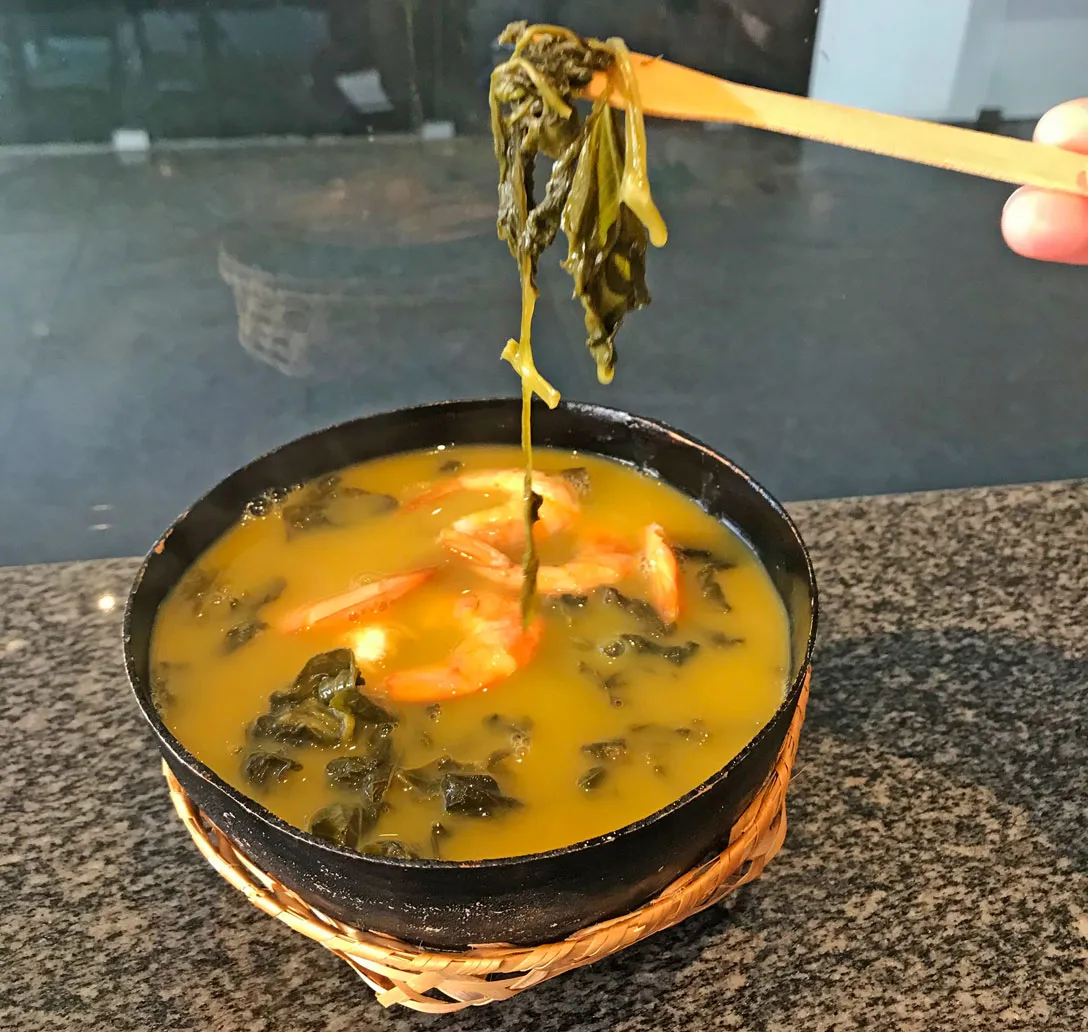
Tacacá, the soup with the magic alga
Casquinha de caranguejo is also very good: a dish made of minced crab. And don’t forget to try cupuaçu or tapioca ice cream!
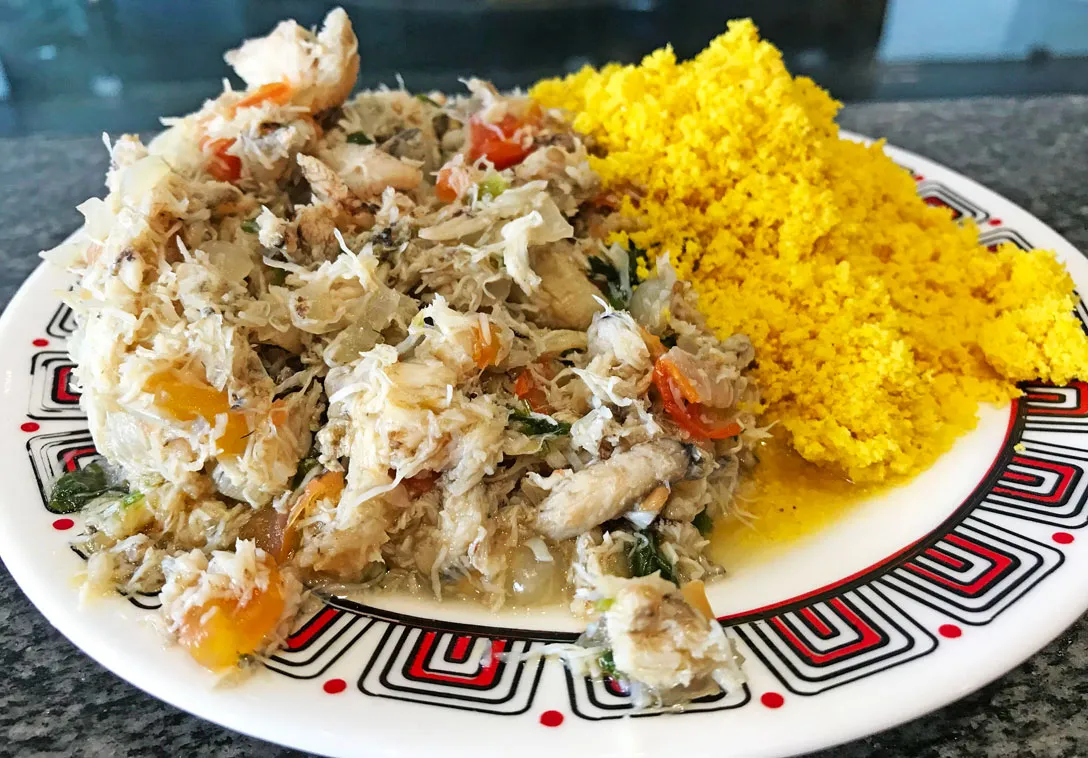
Casquinha de caranguejo served with farofa
Sweets and desserts are also very good in Brazil. The most famous is the Brigadeiro, a bonbon made of chocolate, butter and condensed milk: very sweet! The best place to try it (even if quite expensive) is the Confeitaria Colombo, the most famous confectionery in Rio, located in Centro.
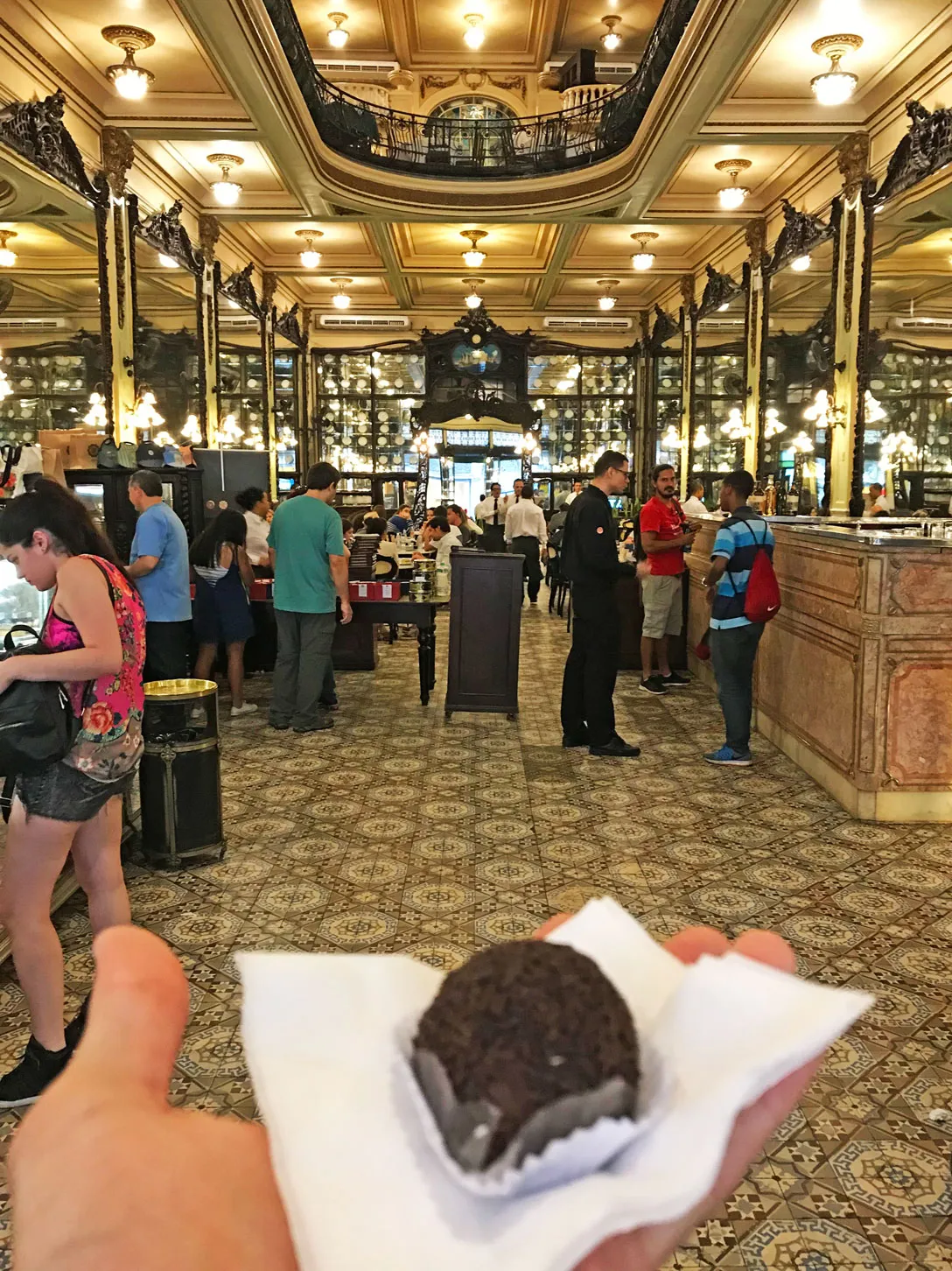
Having a Brigadeiro at the Confeitaria Colombo
I discovered that the main ingredient of Brazilian cuisine is aipim, also called mandioca, a woody shrub native to South America. It’s very similar to what Spanish call yucca and it’s used everywhere. Tapioca is made of aipim. Escondidinho is mashed aipim. Farofa (a powder that is served with almost every dish) is toasted aipim flour. You will end up trying it eventually for sure!
People
As usual, what I like the most is the people. Cariocas are so open and welcoming, they love to meet foreigners and show them their amazing city, giving tips and recommendations.
My local experience started when I downloaded the Couchsurfing app and I joined the weekly meetup: I met so many nice locals (everybody with a good knowledge of English) and one of them, Marcos, invited me and my friends to do a pub crawl in his favorite bars in Santa Teresa. Another girl from Couchsurfing, Daniella, joined us and there was when everything started.
In the following weeks, I found myself dancing all the night in very local samba places, going to restaurants known only by locals, having a homemade Brazilian breakfast and dinner prepared just for me, watching Brazilian movies on Netflix… Best time ever!
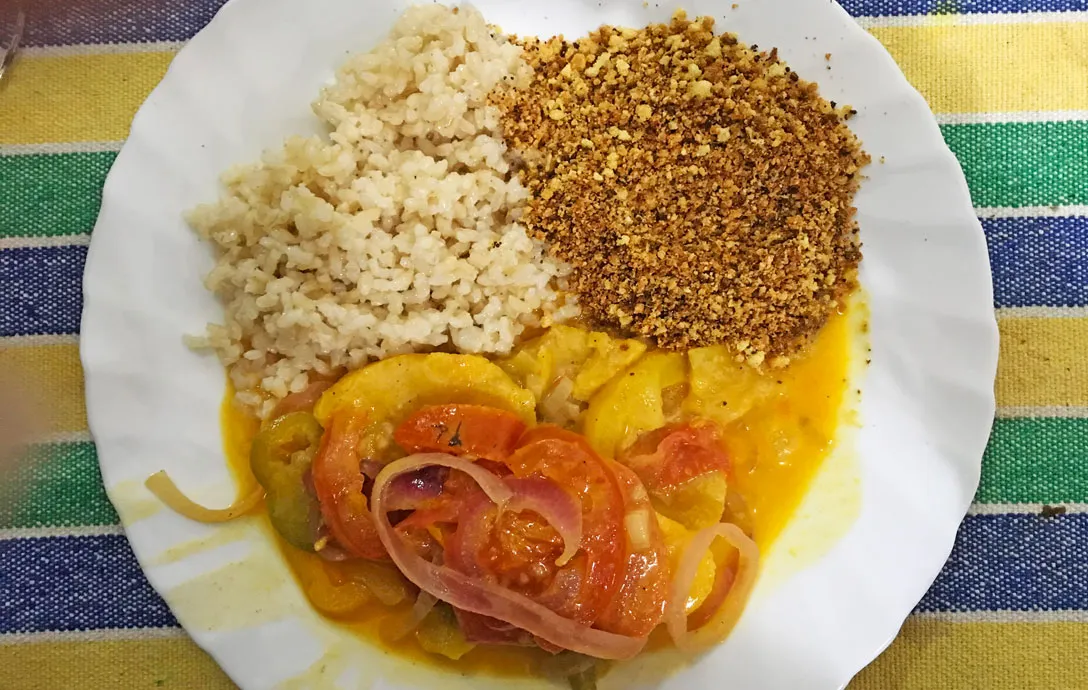
Homemade vegetarian moqueca (thanks Daniella!)
I really started to feel at home, having my own routine: working during the day, practicing capoeira in the evening and then meeting friends, living like a local. I could probably think about living some more months in Rio!
Safety
Yes, I felt like home. But I never let my guard down! Rio is one of the most dangerous cities in South America: you have to be careful of being pickpocketed, but you can also be assaulted with knife or gun!
Nothing happened to me in one month. Probably I was lucky, but I also just followed the basic common sense rules: don’t walk alone (drunk or sober) during the night, don’t enter favelas, don’t go on the beach by night, avoid dangerous districts. I always used Uber for coming back home at night (it’s very cheap and also legal in Rio), asking to stop exactly in front of my apartment.
Anyway, if someone threats you (even without any weapon), just give him everything: don’t try to react or to run away as they can have a gun and just shoot you. It can happen.

The favela close to our apartment
Crime in Rio is a huge problem and so are favelas, where there is no law but the drug lords’ rules. There are some favelas you can actually visit with guided tours, but I was told that it was a bad period as there were many fights between gangs and police. When you enter a favela you are totally safe from crime: nobody is going to rob you, because it’s forbidden by the drug lord. You will likely see criminals with rifles, totally ignoring you. From this point of view, it’s safer inside a favela than outside, as criminals go in the city to steal. The main problem is being involved in a shooting between gangs or with the police. If your apartment is close to a favela, in fact, you can often hear gunshots during the night.
What to do in Rio
Rio has so many things to do! The most famous is hiking up to Corcovado, the hill with the Christ Redeemer. You can go by Uber, getting as close as possible to the top. Once there, you have three options: getting the train, the bus or hiking up in the jungle. The last one is totally not recommended as people say that the jungle is full of muggers, ready to assault you.
So we choose the third option (ha!) and it was amazing! We found ourselves deep in the jungle, following a path that climbs up among a real amazon forest, making you forget that you are in the city. We just met some other tourists but absolutely no muggers and no risk at all.

On the top of Corcovado with the Tribe!
Once on the top, the view is amazing. The only problem is that, if you go during the weekend, it’s very crowded and it’s almost impossible to get a picture with the Christ, without other people in it. Anyway, it’s a must to do.
The other famous hill is the Pão de Açúcar (Sugarloaf mountain): you can reach the Morro da Urca by Uber and get the cable car to the top of the first hill. But you can also hike it up if you feel like walking: it’s an easy half an hour hike. From Morro da Urca, you can then get a second cable car to the higher Sugarloaf mountain and enjoy a nice sunset. The price of the two-way cable car is about $20.
The highlight of the city center is the Escadaria Selarón, a long stair decorated with colorful tiles by the Chilenian artist Jorge Selarón. He spent his entire life working on it, selling his paintings in order to fund the project, and soon people started to help by giving him tiles from every part of the world. You can walk it to the top and reach the Santa Teresa district.
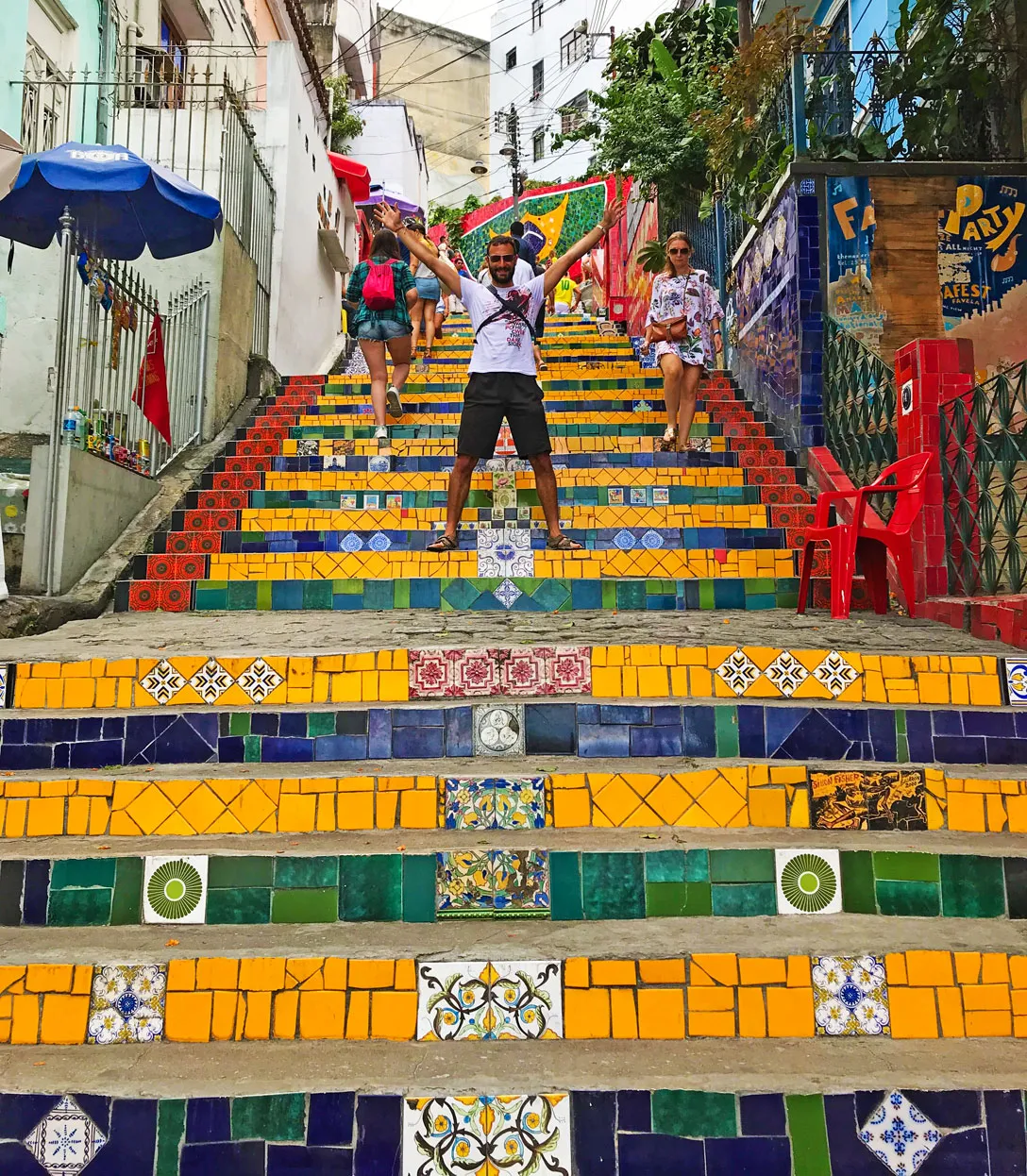
The colorful Escadaria Selaron
Apart from hipster bars, Santa Teresa is famous for the Parque das Ruinas, a nice park with a renovated ancient colonial building in the middle. You can climb it up to the last floor and have a 360 degrees view from the middle of the city, allowing a different perspective.
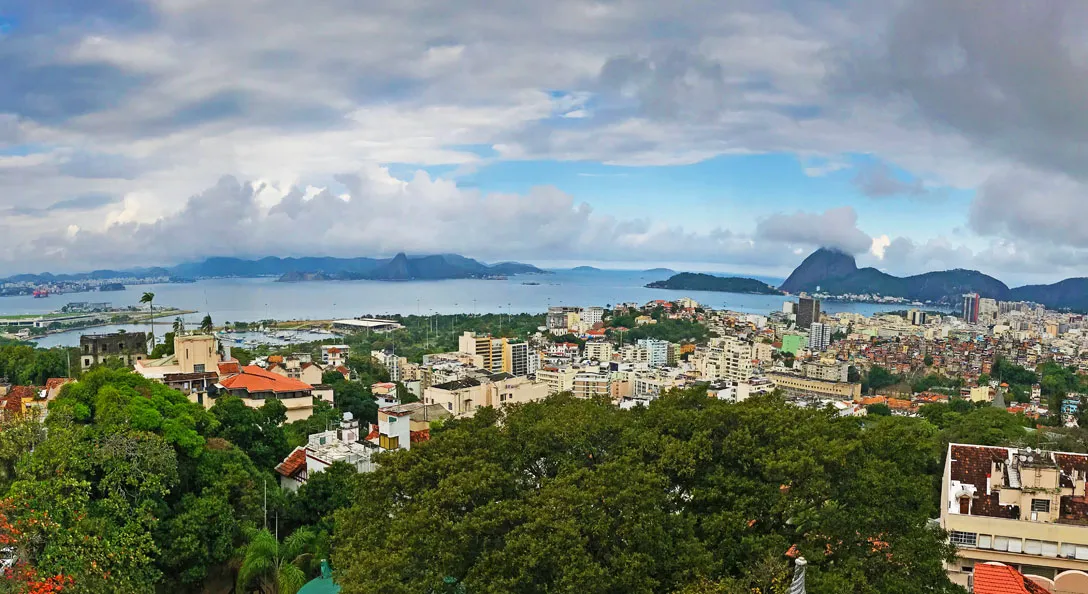
The 360 degrees view from Santa Teresa
From Santa Teresa, you can go back to the Centro, by getting the tram that goes through some other colonial buildings, pass over an old aqueduct and stops in the Lapa district. It costs 20 reais, but it’s a nice local experience, as it used to be the main transportation for people living in Santa Teresa.
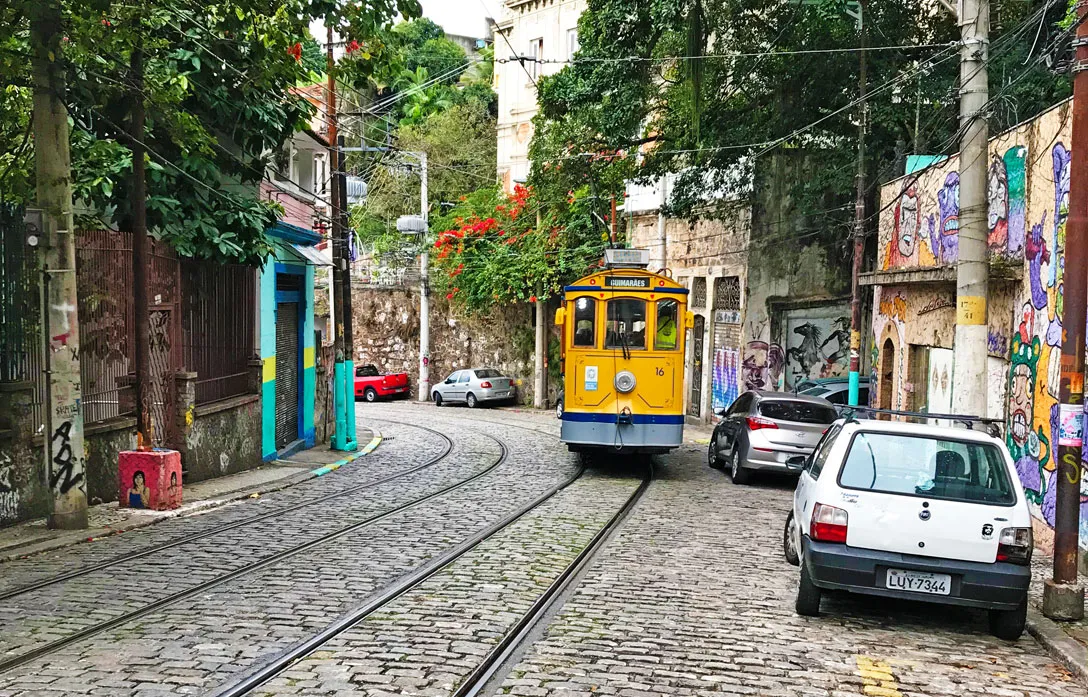
The tram in Santa Teresa
Along the coast, near the port, you can find the Boulevard Olímpico, a long walkway built for the Olympics following the Barcelonian model. Here you can admire “Etnias”, the biggest graffiti in the world that symbolizes peace and union among countries.
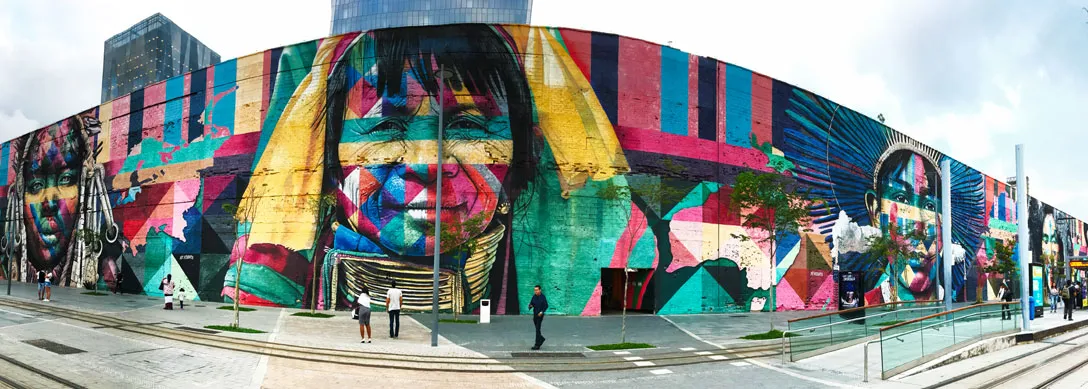
“Etnias”, the biggest graffiti in the world!
Of course, I also have to mention again the beaches of Copacabana and Ipanema, where you can sunbathe and play volleyball. I also recommend to go to Pedra do Arpoador, the stone that divides the two beaches and it’s a perfect viewpoint for admiring the sunset. Its right side is also the main spot for surfers.
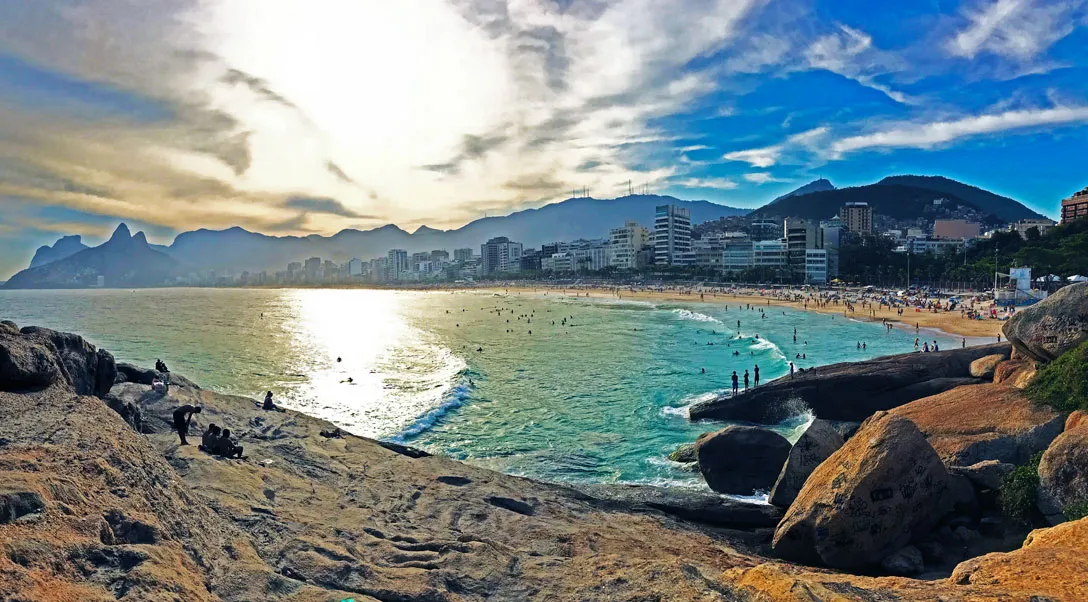
View of Ipanema from the Pedra do Arpoador
Finally, the Botanical garden is also worth a visit: it’s a big park where you will see many types of vegetation: from plants of the Amazon to bamboo forests, orchids, giant palms…
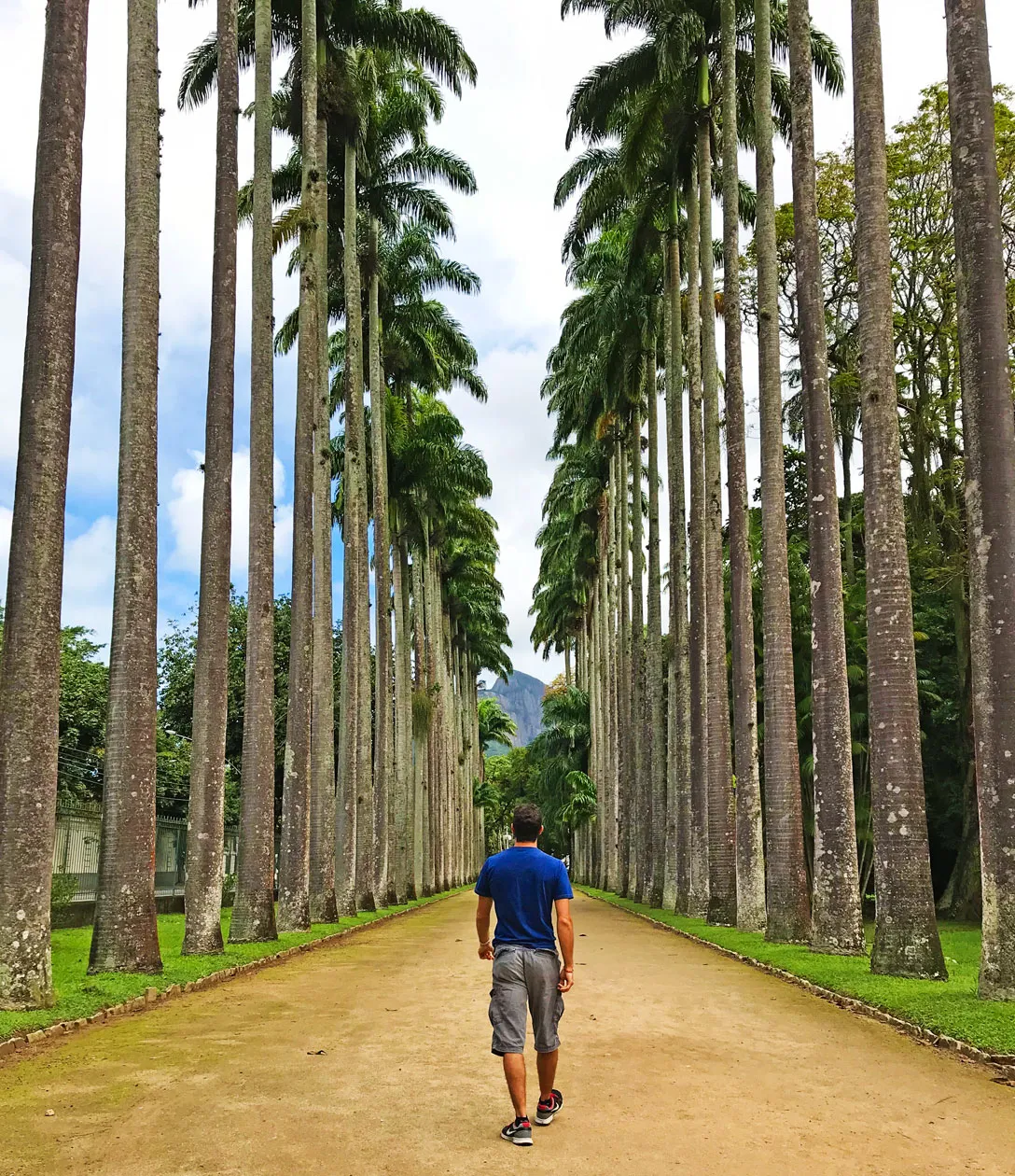
Walking among huge palm trees in the Botanical garden
There are also many animals like monkeys, capibaras and giant carps!
Close to that park, there is also Parque Lage, famous for a colonial villa with a restaurant where there is usually live music and events.
What to do outside Rio
Brazil is huge! While in other countries we used to travel more and visit many places outside the main city, this time we almost stayed in Rio all the time. There are many things you can see in Brazil, from cities like Salvador to the Amazon or the desert. The problem is that for reaching them you have to fly for many hours and it can be very expensive if you don’t buy the tickets on time.
The only real trip we did was going to Ilha Grande, an amazing green island about 140km from Rio. We went to Conceição de Jacareí by Uber (about 2 hours and a half driving) and from there we got a boat to the island.
The island is amazing, covered by jungle vegetation and full of nice beaches. The first day we booked a boat tour that brought us to the main beaches of the island and on other little islands nearby. Beaches were white and the water very green! The second day we hiked to the other side of the island, reaching a beach which is supposed to be the second best beach in Brazil.
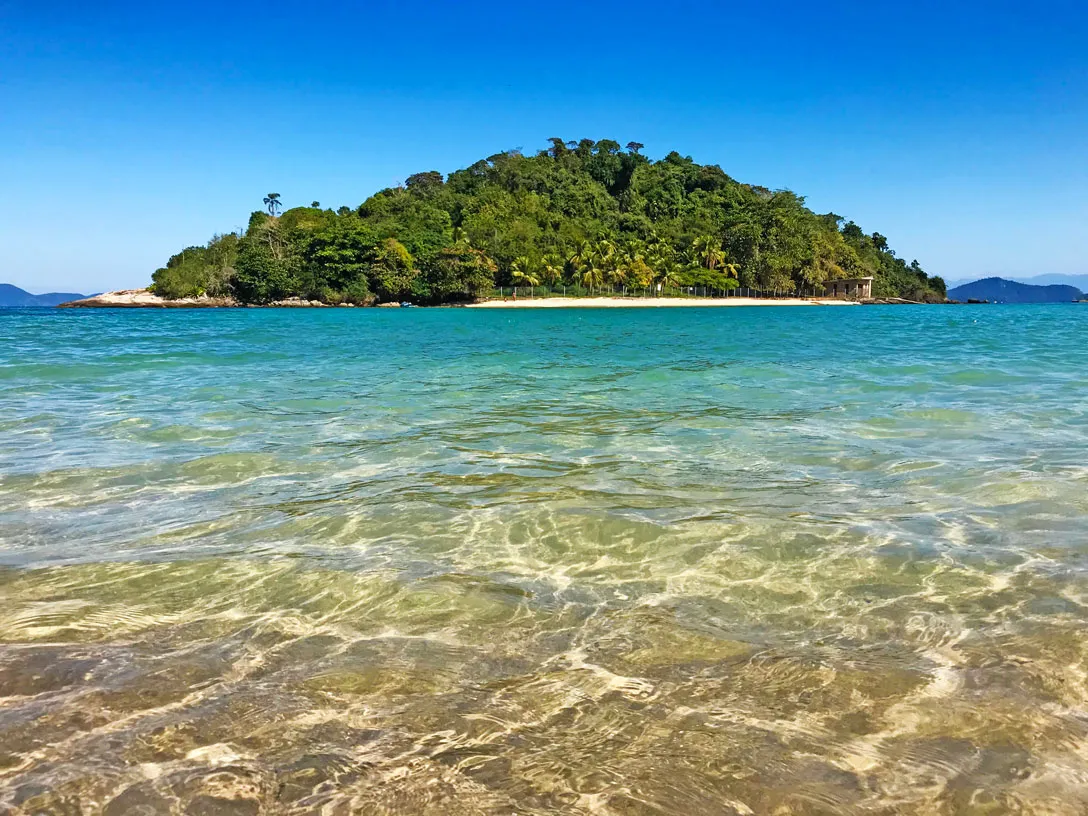
Ilha Grande, with its beautiful green water!
Other things we did around Rio were some hikes to Pedra do Telegrafo (an Instagramable famous rock where you can hang and it seems you are suspended over the edge) and Pedra Bonita.

Diego hanging on the Pedra do Telegrafo - Photo by Genna Contento
How much did I spend?
Rio is very expensive, probably the most expensive country in South America where I have been so far. A dinner with just a drink usually costs at least $20, but it can reach $30-40.
I cooked my own food almost every day for lunch, but also the supermarket was expensive!
This is the breakout of my expenses:
- WifiTribe fee: $800
- Restaurants and drinks: $680
- Groceries: $130
- Weekend trips: $200
- Uber: $90
- Metro: $10
- SIM card: $20
- Sports: $60
- Clubs: $30
In one month I spent about $2,000, plus $330 for the flight to Rio. More or less close to the other countries where I have been. The main difference is that I saved on weekend trips, but I spent a lot on food! Not the cheapest place where to live.
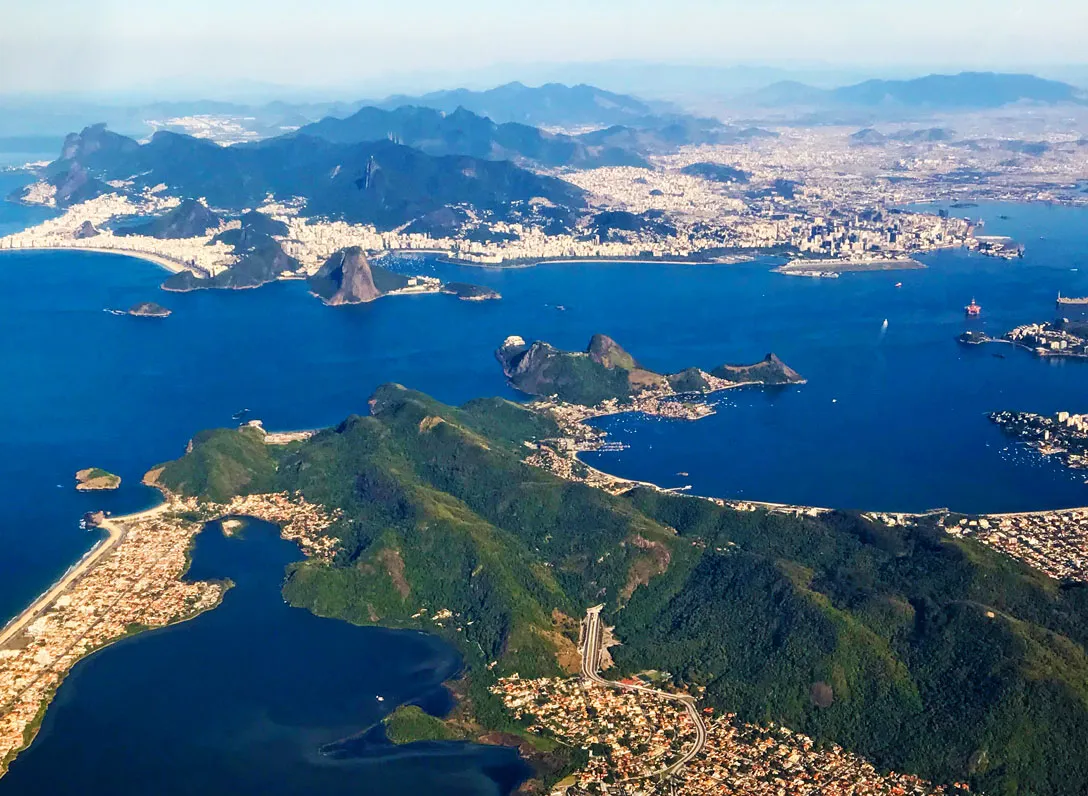
Leaving Rio de Janeiro :(
Conclusions
Rio is the most fascinating city in the world to me and I want to come back as soon as possible! Probably for the next Carnival, why not? It has its problems, of course, but if you are careful you can enjoy it.
Rio, you stole my heart! See you soon!
 Nomad Life
Nomad Life